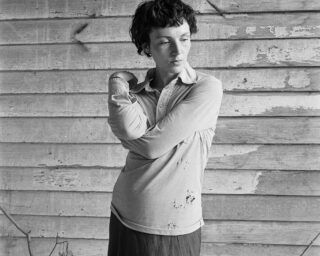Martin Parr on educator Corinne Noordenbos
As part of Photography As You Don’t Know It (Aperture, Winter 2013), we asked three photographers to select a photography-world figure whose contributions to the field have been overlooked. Here, Martin Parr speaks about the wide-reaching influence of Dutch photography educator Corinne Noordenbos.
With the renaissance of photobook publishing that we have witnessed in the last decade, one country has really stood out for both design and content: the Netherlands.
Many books that are now celebrated, such as Empty Bottles by WassinkLundgren, published in 2007, and Communism & Cowgirls by Rob Hornstra, published in 2004, were made by students of Corinne Noordenbos while they were still at college. Teaching first at the Hogeschool voor de Kunsten Utrecht and more recently at the Royal Academy of Art in The Hague, Noordenbos has always made the preparation of a book for the final-year project a central theme of her teaching.
The Netherlands has always enjoyed a strong sense of design, and this, combined with a very distinct and strong photographic culture, has allowed the photobook to flourish. Dutch photographers like Ed van der Elsken understood the importance of the book, and he was the first photographer to introduce different covers for books published in different territories. Building on this legacy, Noordenbos has always introduced the history of Dutch photobook publishing to her students, and shared, very enthusiastically, many books from her own collection.
A decade ago she also invited Bart Sorgedrager—a close friend, fellow bibliophile, and photographer who has specialized in making books around companies set to close—and sociologist Ineke Teijmant to think about devising a documentary project to include as part of the course, with a book as the final work. This made the students focus on locating and exploring subjects that took them away from their comfort zones. Think, in contrast, of how many students would otherwise end up doing projects around their own friends and family.
A good photobook will not only contain strong images and narratives, but will also explore different design and production techniques. Another of Noordenbos’s students was Viviane Sassen, and it was during Sassen’s time in school that the work and design for the now-famous book Flamboya (2008) emerged. Here, the cut and half-pages, integral to the book’s flow and part of its unique presence, were evolved and developed.
More recently, Pieter van den Boogert produced a book titled What We Wear (2011). Gerry Badger and I include this excellent book in volume three of The Photobook: A History. Using an accordion construction, the book shows clothes made in Bangladesh, used in the Netherlands, and finally dumped in Ghana to be sold on cheaply.
What is really impressive about the collaboration between Noordenbos and her students is the professional standard of their work. The bar is set high. They devise good projects and make good photographs, and the presentation of these projects in book form has taken the students’ ambition and achievements to new levels. Noordenbos is an unsung facilitator of the photobook, and her work is mostly unrecognized, so I relish this opportunity to correct this oversight. She has made a very positive contribution to the Dutch photobook culture, which along with Japan is the most mature and exciting in the world. I look forward to seeing many more new and stimulating books from the Noordenbos stable.
—
Martin Parr is a curator, editor, and photographer. He is a member of the Magnum agency and has published over sixty books. His third volume of The Photobook: A History will be published this spring.























